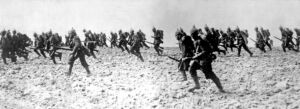Business & Education
Fighting for the fatherland: with pride or with perturbation
This article is more than 10 years old.
Half of the 30,000 Danes recruited by the German Empire in North Schleswig were happy to do their duty, while the remainder did so, quietly hoping they would lose

Many of the German soldiers were actually Danes (photo: Underwood & Underwood)
Europe stood on the edge of the precipice in 1914, as countries across the continent began mobilising their armies for what was expected to be a short war. Though Denmark remained neutral during the First World War, 30,000 Danish soldiers from North Schleswig were called into service to fight for Germany.
Sweeter on Schleswig
Schleswig and Holstein had been Danish duchies since 1773, but were not part of Denmark. German nationalist sentiment, which was awoken during the Napoleonic Wars between 1792 and 1815, called for the two regions to be absorbed into the German Confederation as a single state, and following the Congress of Vienna in 1815, Holstein was incorporated into the confederation. This prompted a counter-movement in Denmark, where nationalists sought to detach the two regions and incorporate Schleswig into Denmark.
In March 1848, an uprising led by Schleswig-Holstein’s German majority and aided by the Prussian military started a three-year war between Denmark and Prussia, which ended with the London Protocol of 1852. Schleswig-Holstein was returned to Denmark, and the Danish government agreed to stop pursuing closer ties with Schleswig than with Holstein.
1864 … now that rings a bell
In 1863, under pressure from a liberal government, Danish monarch Christian IX signed a new constitution for Denmark and Schleswig. Germany declared this was in violation of the 1852 protocol, and in January 1864, Austria and Prussia declared war on Denmark. Danish resistance was swiftly crushed in two short campaigns. Christian IX ceded Schleswig to Prussia and Holstein to Austria.
The distribution of the territories was deliberately chosen by the Prussian minister-president, Otto von Bismarck, who went on to become the first chancellor of Germany, to create friction between Austria and Prussia, and in 1866, war broke out between the two. Austria was defeated after seven weeks, and Prussia annexed Holstein and Lauenburg, merging the regions with Schleswig to create the Schleswig-Holstein province. The Danish-speaking majority of North Schleswig thus found itself under Prussian rule.
After the unification of the German Empire in 1871, the new issue at hand was the fate of North Schleswig. The Treaty of Prague, which ended the Austro-Prussian War, provided that the region would be returned to Denmark if a majority of the population elected to do so in a plebiscite. Prussia and Austria annulled this provision in 1878, leaving the future of the area’s Danes in German hands.
Deserters dash to Denmark
As part of the empire, the Danish population of North Schleswig was expected to contribute to the German war effort. On 31 July 1914, Germany prepared to declare war on Russia. All able-bodied men aged 18-44 were told to report to the barracks by 2 August, where they would receive one week of training before being sent to the frontline.
The difference between the pro-Danish and pro-German factions of North Schleswig was evident. The pro-Germans shared the prevailing sentiment of German nationalist pride, while the Danes felt they bore a heavy duty, forced to fight for an army they wanted to see defeated.
Danish resentment was fuelled further by German worries that pro-Danish soldiers would try to escape over the border to neutral Denmark, which led to a general reluctance to grant those soldiers leave. Some 2,400 soldiers successfully fled to Denmark, and German authorities took decisive actions against their families.
A sense of duty to the Fatherland
However, there were many in the Danish community who encouraged the soldiers to tow the line, and those who had not joined up to enlist. It was hoped that fulfilling their duty to the German Empire would increase their bargaining power in their quest for a plebiscite. War also appealed to the soldiers’ sense of adventure, though this quickly faded as an end to the war began to look less and less likely.
When the war finally ended on 11 November 1918, about 30,000 Danish men from North Schleswig had seen service. About 5,200 had died, leaving behind 1,500 widows and 5,000 orphans. Survivors bore physical and mental scars – their reminders of the brutality of war.
The plebiscite promised in 1866 was not held until 1920, when 70 percent of the northern part of North Schleswig voted to join Denmark, while 80 percent of the southern population voted to remain German. It is believed the retention of the northern part of North Schleswig owed much to those who had vacated the area to avoid conscription and never returned.
Ramifications still felt today
In 2012, a decision taken by the Culture Ministry to withdraw funds previously allocated to renovating the graves of fallen Danish soldiers in a French cemetery came under fire from the inhabitants of what was once a German territory. The cemetery was built in 1924 and is the resting place of 79 Danish soldiers. The graves are in need of restoration.
“Other countries maintain their memorials abroad, and if the Danish ones just rot, it sends the message that we do not care about our fallen soldiers,” Ellen Trane Nørby (Venstre), a member of parliament, told Berlingske at the time.










































